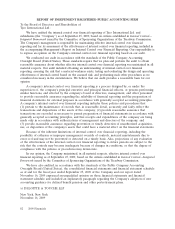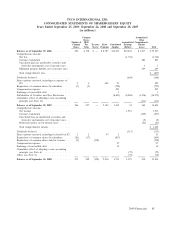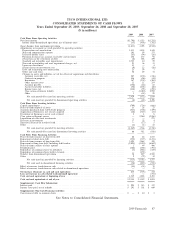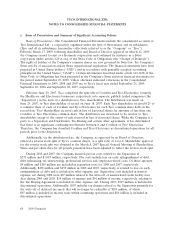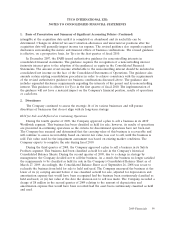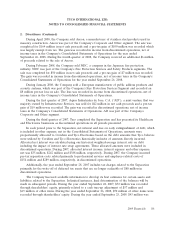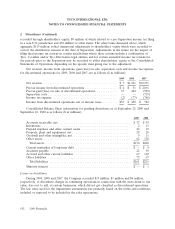ADT 2009 Annual Report Download - page 184
Download and view the complete annual report
Please find page 184 of the 2009 ADT annual report below. You can navigate through the pages in the report by either clicking on the pages listed below, or by using the keyword search tool below to find specific information within the annual report.TYCO INTERNATIONAL LTD.
NOTES TO CONSOLIDATED FINANCIAL STATEMENTS
1. Basis of Presentation and Summary of Significant Accounting Policies (Continued)
Subscriber system assets and any deferred revenue resulting from the customer acquisition are
accounted for over the expected life of the subscriber. In certain geographical areas where the
Company has a large number of customers that behave in a similar manner over time, the Company
accounts for subscriber system assets and related deferred revenue using pools, with separate pools for
the components of subscriber system assets and any related deferred revenue based on the same month
and year of acquisition.
Effective as of the beginning of the third quarter of 2007, Tyco changed the depreciation method
and estimated useful life used to account for pooled subscriber system assets (primarily in North
America) and related deferred revenue from the straight-line method with lives ranging from 10 to
14 years to an accelerated method with lives up to 15 years. The accelerated method utilizes declining
balance rates based on geographical area ranging from 160% to 195% for residential subscriber pools
and 145% to 265% for commercial subscriber pools and converts to a straight line methodology when
the resulting depreciation charge is greater than that from the accelerated method. The Company will
continue to use a straight-line method with a 14-year life for non-pooled subscriber system assets
(primarily in Europe and Asia) and related deferred revenue, with remaining balances written off upon
customer termination.
The change in the method and estimated useful life used to account for pooled subscriber system
assets and related deferred revenue resulted from our ongoing analysis of all pertinent factors,
including actual customer attrition data specific to customer categories and geographical areas, demand,
competition, and the estimated technological life of the installed systems. The pertinent factors have
been influenced by management’s ongoing customer retention programs, as well as tactical and strategic
initiatives to improve service delivery, customer satisfaction, and the credit worthiness of the subscriber
customer base. The change in method used to account for pooled subscriber system assets and related
deferred revenue accounts represents a change in accounting estimate effected by a change in
accounting principle and was accounted for prospectively. The change in method was based on
information obtained by continued observation of the expected benefits inherent in the pooled
subscriber system assets by customer category and was preferable, as it resulted in depreciation and
amortization that are more reflective of the pattern of expected benefits derived from these assets. All
pertinent factors, including actual customer attrition data specific to customer categories and
geographical areas, demand, competition, and the estimated technological life of the installed systems,
are reviewed by the Company at each balance sheet date to assess the continued appropriateness of
methods and estimated useful lives.
The effects of the change described above decreased net revenue by $21 million, decreased
depreciation expense by $37 million, and decreased loss from continuing operations and net loss by
$10 million each and increased basic and diluted earnings per share by $0.02 for 2007.
Long-Lived Asset Impairments—Tyco reviews long-lived assets, including property, plant and
equipment and amortizable intangible assets, for impairment whenever events or changes in business
circumstances indicate that the carrying amount of the asset may not be fully recoverable. Tyco
performs undiscounted operating cash flow analyses to determine if impairment exists. For purposes of
recognition and measurement of an impairment for assets held for use, Tyco groups assets and
liabilities at the lowest level for which cash flows are separately identified. If an impairment is
determined to exist, any related impairment loss is calculated based on fair value. Impairment losses on
92 2009 Financials


